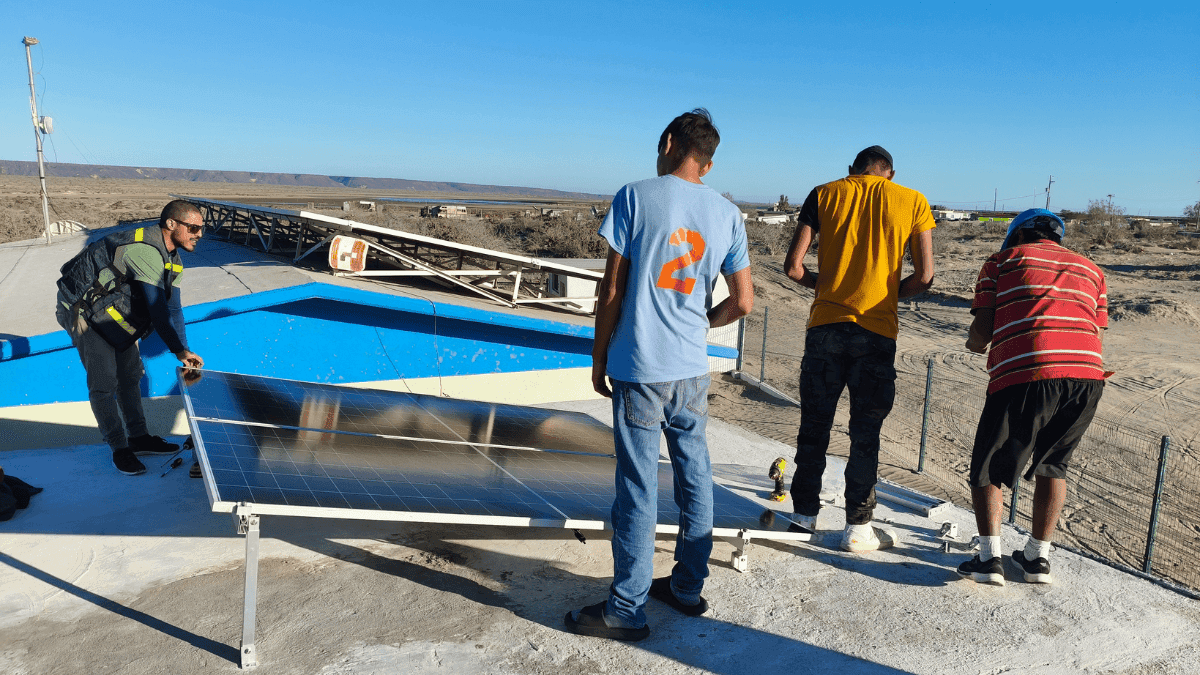For the rest of the year, the Center for Renewable Energy and Environmental Quality (Cerca) will inaugurate two new solar kiosks that will expand its rural electrification network in Baja California Sur.
It will be the first experience of the program in areas that need at least a few hours a day of energy, such as the Sierra de La Candelaria, north of Los Cabos, whose kiosk begins on November 27; and in San Luis Gonzaga, Comondú, which will begin tests in December.
These kiosks are built by photovoltaic modules that provide electrical energy, and that connect underground wiring to centers that the community decides to prioritize, such as schools, fields, health houses and sub-delegations. This is the core of a model called social energy, a scheme that not only installs equipment, but is part of the community organization to decide how and where energy is distributed.
“We realized that isolated communities were not only off the power grid, but also territorially. Each hurricane breaks down roads and they remain isolated for up to a month,” explained Jaqueline Valenzuela, director of the civil association, Cerca. “That's where the idea of offering them local solutions that meet their basic needs and that communities themselves can operate and maintain.”
From vulnerability to social energy
The project was born in 2021, after Cerca identified 63 communities without an electrical connection in Baja California Sur. In many of them, electricity came from small diesel generators that were barely enough to keep the light on for a few hours.
Based on an energy diagnosis published in 2022, the civil organization designed a strategy for solutions to emerge from the communities themselves through school workshops, local meetings and a process of prioritizing collective needs.
“The communities clearly told us what they needed: cooling, lighting, communication and a little bit of climate comfort,” Valenzuela said.
Based on these demands, Cerca designed solar kiosks, whose isolated photovoltaic system consists of four panels and a battery that allows storing enough energy to keep electrical devices active for three days, even if there is no sun.
So it is possible to continuously sustain basic activities such as lighting community spaces, a refrigerator to preserve food, a fan for several hours, and the daily charging of cell phones, radios or computers.
The result is local microgrids that today supply two fishing communities: Puerto Chale, in La Paz, and El Datile, in Mulegé. In both, kiosks transformed daily life, Valenzuela said, health offices extended their hours, students increased and formalized classes, and the fields were filled with young people again after sunset.
Energy that educates
The most visible impact occurs in classrooms and health centers. In Puerto Chale, the electrification of the school hostel (educational and care facilities that provide lodging and food for children and young people) made it possible to improve children's nutrition and maintain enrollment.
“We realized something very sad,” Valenzuela said. “There are several shelters that have been closed due to lack of electricity, and that means that the most remote families can no longer study. Electrifying a hostel means keeping an opportunity alive.”

In La Candelaria, where the new solar kiosk will be inaugurated on November 27, the remote secondary school and the community hostel will be the first to benefit. Until now, classes are interrupted when the power fails and the heat in the classroom becomes unbearable.
“They do work, but let's say it has intermittences. Enrollment is limited. Already in the voice of the directors, you learn that the challenge of not having electricity in a constant, sufficient and, above all, quality way, limits activities. They say, well, I do what I can and receive what I can.”
In San Luis Gonzaga, another of the next communities, energy will be used to reactivate a Jesuit mission that has been abandoned for years. The community voted to electrify a small visitor center to boost cultural tourism. “We want energy to help recover community life,” Valenzuela explained.
Communities in transformation
Since the first solar kiosk was installed in 2023, Puerto Chale has held festivals, soccer tournaments and school ceremonies under electric light. The local sub-delegation processes birth certificates online and the health center's doctor uses computers and the internet to treat patients.
“Communities organize to decide which centers to connect to and how to take advantage of energy; this promotes cohesion and reduces marginalization,” Valenzuela said.
The Cerca model isn't just about donating infrastructure. Each kiosk is delivered as a gift: the community maintains the system whenever it performs activities that benefit everyone.
“The condition for the kiosk to remain is that they continue to do community activities. What we are looking for is social cohesion, not just electrification,” he explains.
In this process, women have acquired an important role. In Puerto Chale and El Datile, the technical liaisons are local women who are responsible for maintaining the system.
A model that expands
The project has directly benefited some 700 people in its first two communities, although the number of services — medical consultations, sports activities, classes, procedures — numbers in the thousands.
In the coming months, with the new facilities in La Candelaria and San Luis Gonzaga, Cerca will consolidate its vision of a network of rural microgrids, interconnected and managed by its own inhabitants.
“The important thing is not to install systems, but to accompany communities in their growth,” Valenzuela concluded. “We want energy decisions to come from the community, to define themselves how far they want to grow and how to do it.”
With the expansion of the program, Cerca aims to gradually reach the dozens of isolated communities in Baja California Sur that are still without an electrical connection. But beyond the numbers, the impact of each kiosk is measured in everyday life: in the light that keeps a remote control open, in the refrigerator that preserves a family's food, or on a court that comes back on.



Comentarios (0)